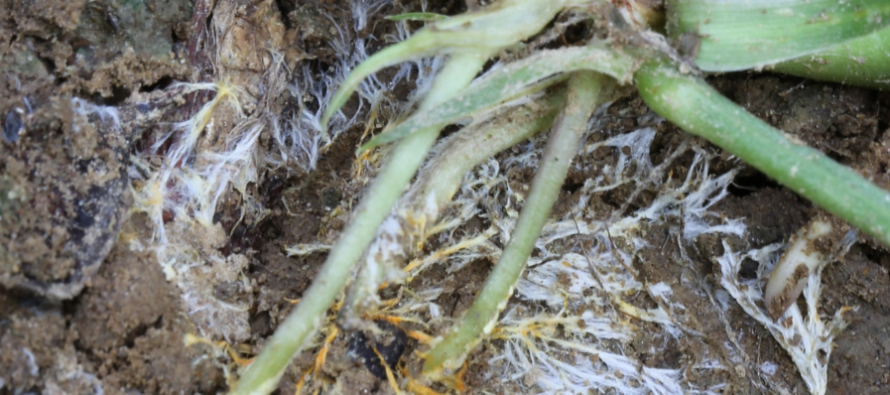Southern Blight of Peanuts – It’s Arrived

Southern blight, has been found on peanuts in several areas of the state this week.
Southern blight is a plant disease that attacks the crown and below ground parts of peanuts. It causes the plant to wilt and die or reduces nut quality. The best management tool is a rotation with 3 years of a non-leguminous crop. Monocots such as corn, sorghum and milo are superior rotation crops, but cotton is also good. Fungicides can suppress the disease, but seldom stop it.
What’s in a name
White mold vs. southern blight
Recommendations from Georgia, and some fungicide labels use the name “white mold” to refer to southern blight, caused by the fungus Sclerotium rolfsii. This is unfortunate, since there is another disease called “white mold” caused by Sclerotinia fungi. Both diseases are found in Mississippi.
Fungicides that work against southern blight seldom are effective against “white mold”. This means that it is possible to make a very expensive application to control southern blight or “white mold” and it not be effective.
TIP: When reading fungicide labels, look for the scientific name of the fungus “Sclerotium rolfsii” for southern blight and Sclerotinia for True white mold. Call me if you have questions.
southern blight, stem rot, southern stem rot
Southern blight disease of peanuts is correctly termed “stem rot”, and is sometimes called “southern stem rot”. I use the name southern blight because it is the common name used in many other crops for diseases caused by Sclerotium rolfsii, so more people are likely to know. It seems to cause less confusion than other common names.
Southern blight versus a look-alike
The fungus that causes southern blight often begins its growth on crop residue or fallen leaves before parasitising the plant ( e.g. see Figure 1). The characteristic growth pattern is a white, ropey-like mycelium that spreads outward from the starting point, like fingers originating from the palm of the hand (Figure 2).
Figure 1. southern blight began its growth on the underside of this piece of corn stalk residue. Note the decaying leaves in the upper right center. These leaves are being consumed by the Sclerotium rolfsii fungus.
Figure 2. Southern blight growth on the soil surface. Note the “ropey” like white mycelium and the growth pattern.
Look alike
There is another fungus with similar growth, but has a yellow to orange colored base (the starting point) (Figure 3).
Figure 3. A fungus that looks similar to southern blight, but does not hurt the plant. Note the orangish/yellow base of the fungus.
This fungus does not hurt plants. Because of the growth similarities, some growers have applied fungicides for it – an expensive loss. If this fungus grows onto the plant, you can scrape the mycelia off (Figure 3), and the plant will be intact – green and healthy. Southern blight will create water soaked, dark green decaying areas.
Figure 4. The knife blade has scraped away the look-alike fungus. Note the tissue is a healthy green color.
In-season Southern blight management
Southern blight* is on or in the soil. For fungicides to penetrate to the location of the fungus will require two significant practices:
1. Apply the fungicide at night. This will minimize the amount of mix intercepted by the canopy. More of the fungicide mix will contact the soil – where the problem is.
2. Use as much water as your pain threshold will allow. Twenty gallons/A is the minimum.
- Remember that most peanut fungicides move upward in the plant!
- Most fungicides will not move downward in the plant.
- The more water you apply, the more likely it will carry the fungicide downward to the roots.
- The roots will pick it up and move the fungicide upward, protecting much of disease prone area.
There are many fungicides labeled for management of this disease.
My trials over the last two years which looked at applying a fungicide up to 40 days after 100% emergence illuminated two patterns.
All of the six fungicides I used worked better in one field than others. I could not determine what factor(s) influenced a particular fungicides efficacy in a particular field.
The two most consistent fungicides over all fields in both years were Convoy and Fontelis.
* Southern blight is also called stem rot, and incorrectly, white mold. The disease is caused by the fungus Sclerotium rolfsii.
This work has been supported by Mississippi State University Extension Service and the Mississippi Peanut Promotion Board.








I am farmer, in my farm I have seen white mold so which fungicide for it and most effective.